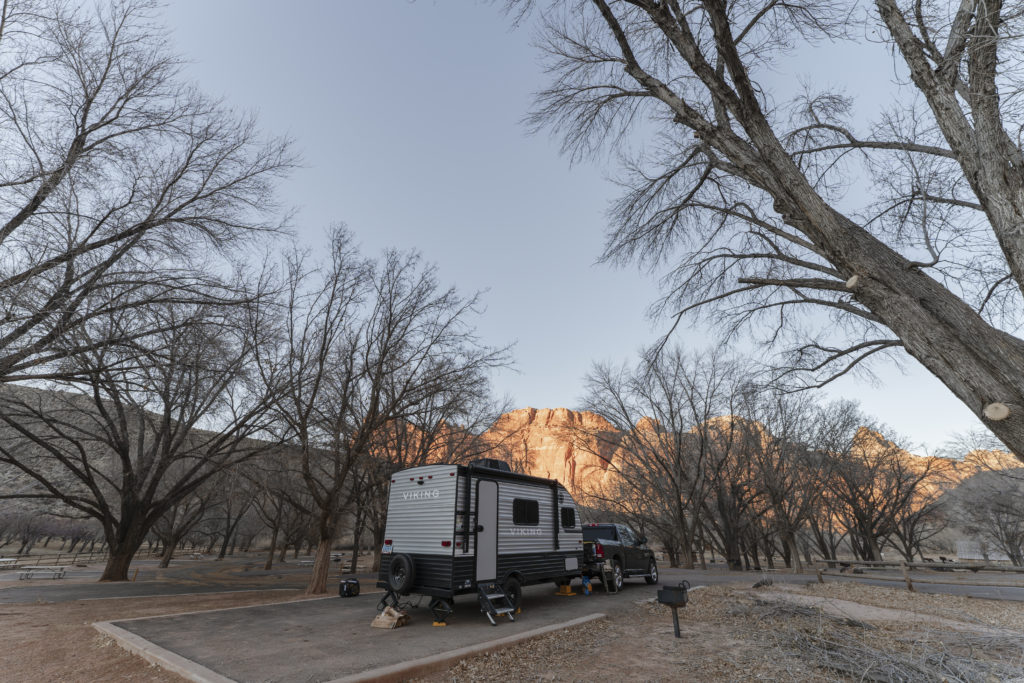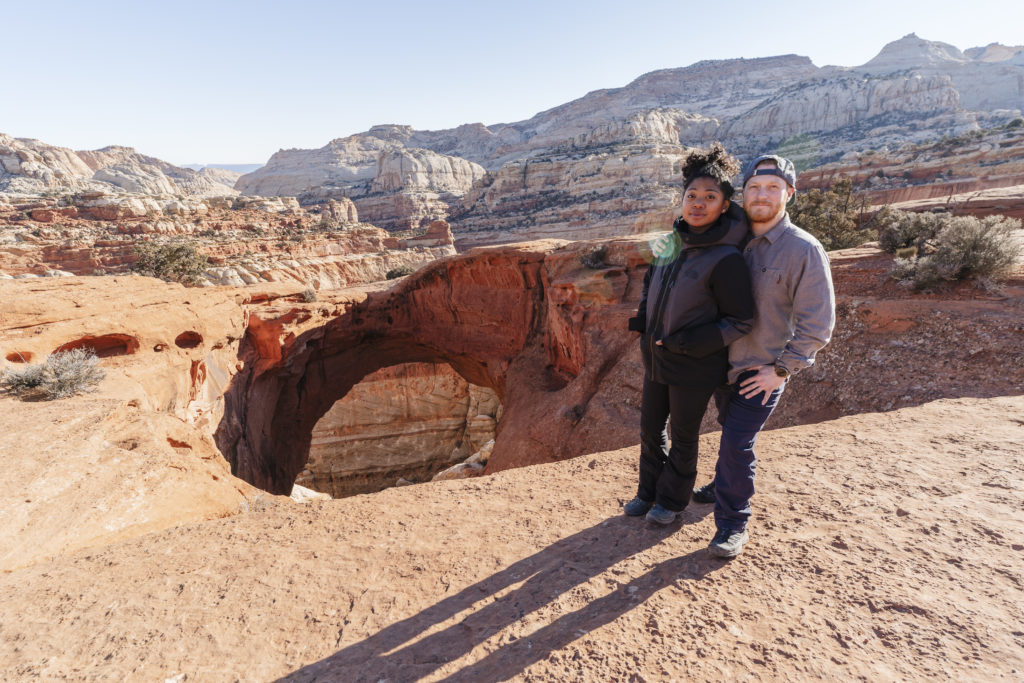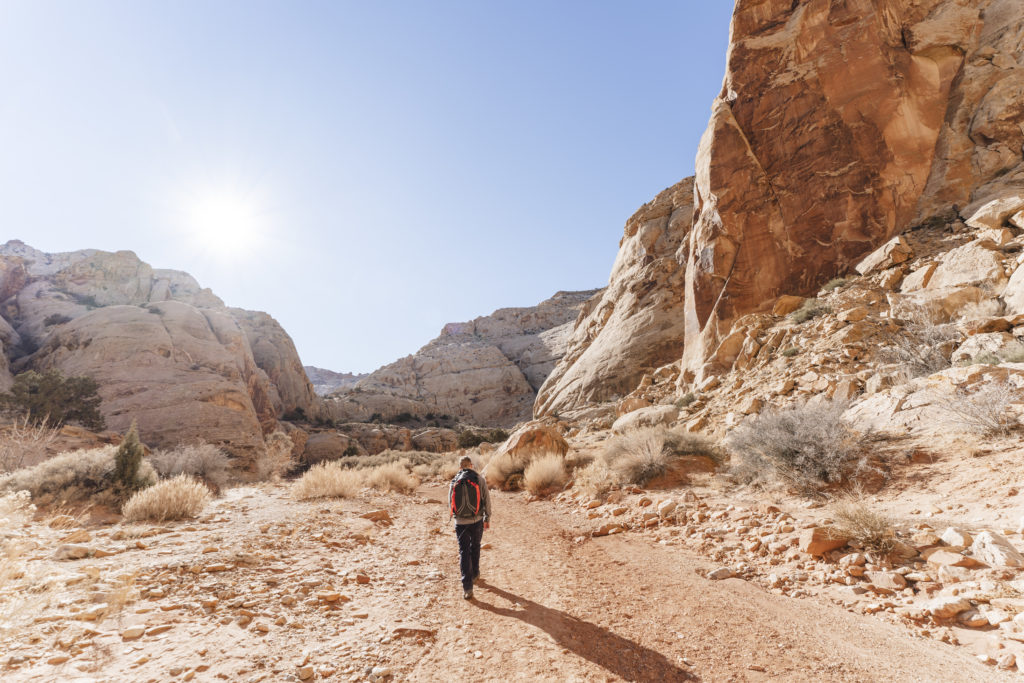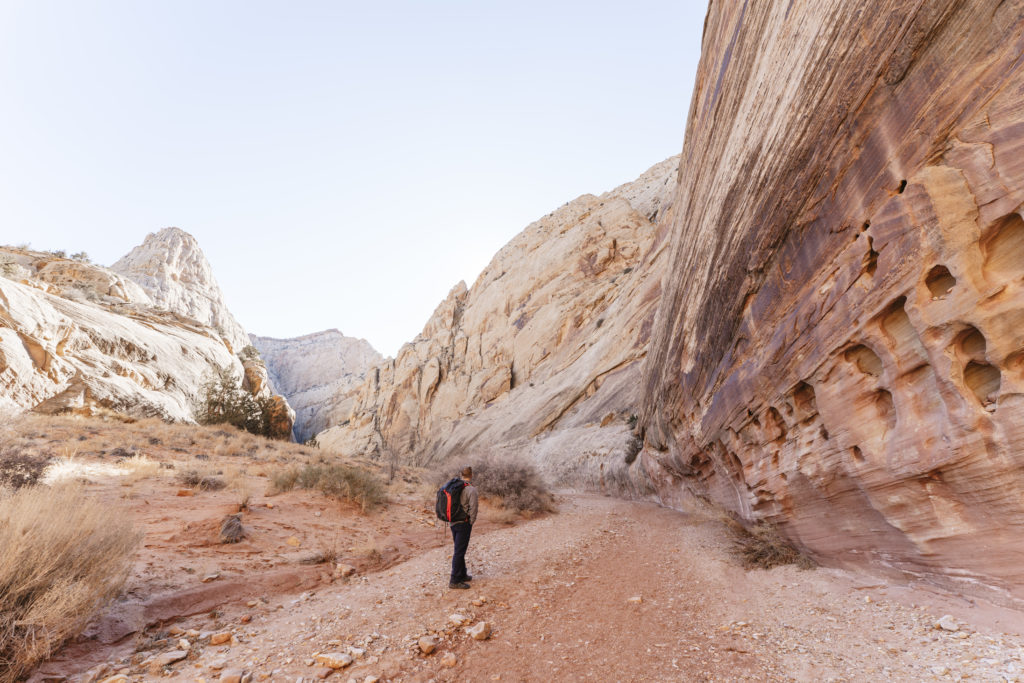48 HOURS IN CAPITOL REEF – WINTER

If you enjoy having a national park practically to yourself, consider visiting Capitol Reef during the winter months. Of course, you should expect snowy conditions and be prepared to adapt your plans as the weather changes constantly. As we planned our two-week trip that looped us through Las Vegas, Southern Utah, and Northern Arizona there was inclement weather in the forecast, but we decided to move forward with our plans. Luckily for us, the ominous forecast kept the crowds away, and since it didn’t snow at all we were able to explore the park all to ourselves. You’ll definitely want to bring those layers though, even with no snow it was very windy on many of the hikes and was cold enough to freeze over at night.
ACCOMADATIONS


Fruita Campground is a first come, first served campsite during the winter. We arrived mid-day on a Thursday in January 2022; there was no guard shack, but we had our National Parks Pass at the ready. When we pulled up to the campground there were so many spots to choose from (only 3 other campsites were occupied during our entire stay). We ended up choosing Campsite 42 in Loop B which is located in the back corner away from the barn on the outskirts of the campground. It was a spacious site with great views of the surrounding rock faces and the historic buildings.
Things to note: There are no hook ups for campers and RV’s, but the sites were level and the campground was easy to navigate with our truck and towable camper.
You’ll definitely see some deer, squirrels, and pheasants in the campground. Although they seem comfortable around people, remember that they are wild animals: do not approach or feed them.
If you’re not camping, there are plenty of hotels within 5-10 minutes outside the entrance of the park. We’re pretty sure some tent campers left in the middle of the night due to the wind and found a local motel. So keep in mind when tent camping during January and make sure you have the proper gear or a back up plan to make accommodations at one of the hotels up the road.
DOG BOARDING
Like many other national parks, dogs are allowed on roads and campgrounds but not on the trails. The nearest option for boarding is Loa’s Ark, 30 minutes outside of the park. It is $10 a day and you pay for what you get: Loa’s Ark is essentially a kennel, I would not describe it as a doggy daycare. We were able to make reservations; I recommend calling a few times and reaching out over Facebook: Loa’s Ark Facebook Page
When we dropped Parker off, we were a little weary about leaving him there overnight since they put him in an outdoor kennel. They did have indoor kennels, we assume they moved the dogs indoors at night. Generally like to ensure he has some outdoor play time whenever we board him. As far as we know, Loa’s Ark leaves the dogs in their kennels the entire time. When we picked up Parker, no one was around, and after waiting a while we just went out to the kennel and took him. They did not even give us a call that Parker was missing after we picked him up.
So, if you do have a dog and would like to experience Capitol Reef, they’re OK for daycare but don’t leave them overnight. Also, anyone looking for a small business idea, open a doggy daycare closer to Capitol Reef with better services!
HIKING
You’ll definitely want to dow
You’ll definitely want to download your trail maps and info prior to arriving at Capitol Reef since there is absolutely no service in the area. Do your research on which trails you’ll want to do beforehand and make a plan that maximizes your day. It’s a big park with lots of winding roads; it’s easy to waste lots of time driving back and forth between trails if you don’t think it through. Consider speaking to the staff at the visitor center for their recommended hikes. Here are some of the trails that I favorited, some completed and some we can’t wait to travel back to.
HICKMAN BRIDGE TRAIL
Our first afternoon hike, we hit Hickman Bridge Trail, Sunset Point, and Gooseneck Overlook.
Hickman Bridge Trail is a good introduction to Capitol Reef. The first half mile is an incline up to the main trail but overall it’s an easy hike. There are some fun surprises on this trail, like these holes in the rocks that you can climb into and lead to mini caverns.



The bridge itself is a photographer’s dream; it’s a grand focal point and the surrounding landscape is picturesque. It’s one of the rare arches that you can really get up close to.





SUNRISE AND GOOSENECKS
Sunset Point is a very short hike with cool overlooks. and Gooseneck is right over the hill.







SUNRISE AND GOOSENECKS TRAIL MAP
CASSIDY ARCH, FRYING PAN, AND GRAND WASH LOOP
Our second day hike was a big one, but well worth the effort. At 10.5 miles long it took us 5 hours and we gained 1,600 feet of elevation. We made a loop by combining the Cassidy Arch, Grand Wash, and Frying Pan trails. If you have two cars, I recommend parking one car at the Grand Wash trailhead and one car at the Frying Pan trailhead so that you can skip the 2.6 miles of the loop that’s just road. Read more below.
We started at 8:30 am and parked at the Cassidy Arch/Grand Wash trailhead which is a turnoff on the Scenic Drive. We recommend going counterclockwise around this loop so that you can accomplish most of the elevation gain within the first 1/3 of this hike. If you end up going clockwise, you’ll have a more gradual incline, it just depends on how you’d like to tackle this trail. Also, a benefit of going counterclockwise is that you get to experience Cassidy Arch in the morning before the crowd (even though, during this time of a year, the crowd levels were low).
Cassidy Arch itself was glorious. You can walk on the top of the arch (not for the faint of heart) and it might be the only arch you can walk on top of in the Southeast area of Utah. It’s a perfect spot to take a snack break and to take in the stunning views surrounding you.


Flying Pan Trail gets you to the top of the mountains in Capitol Reef, it’s tough but worth every step. Little-to-no shade was ok during this time of year because it was a little chilly. Bring a good jacket or else the wind cuts right through you and be careful with your knees on the steep declines there’s lots of loose rocks that can slide.






Once you finish Frying Pan, you’ll see the road and you’re half-way into the loop. This was one of the downsides of creating this loop by stitching together multiple trails. This section was 2.6 miles of walking down the side of the road; it’s a little lackluster, but at least it’s easy. There’s a few points you can stop off to see a creek, some huge cliff faces, and sand banks.






Eventually on the right hand side of the road you’ll get to the Grand Wash Trailhead. This trail puts into perspective how large these rocks really are. Remember this trail is quite literally a wash, so keep an eye on weather advisories. Flash floods do happen. By the time we started Grand Wash it was afternoon, and was the only trail we saw anyone else walking. This was an easy trail with very little elevation gain, lots of shade, great picture stops, and fun places to hear an echo.
CASSIDY ARCH, FRYING PAN, AND GRAND WASH TRAIL MAP
Overall, Capitol Reef seems the least trafficked of the Big 5 Utah National Parks which is probably why it’s my second favorite of the 5. It’s quite and secluded and has some spectacular sites.
Things we missed:
Navajo Knobs Trail
Scenic Drive
Rim Overlook Trail
Pies at Fruita (only available during on season)
Geology Talk at 3PM at the Visitor Center
JOIN THE PARTY!
Subscribe to the True Colors Creative newsletter to learn more about exclusives, updates and more!